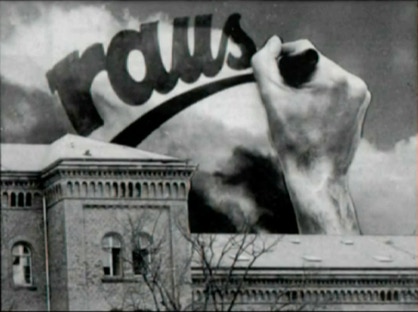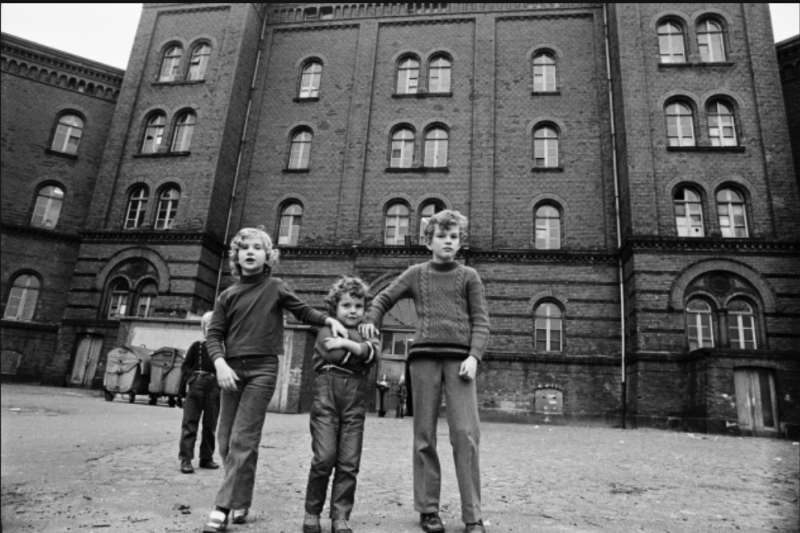Ausstellungseröffnung: Wo wohnen alle Leute?
Exhibition Opening: Where do all the people live?
Di, 03.06. 19:00
Festivalzentrum Post

Täglich geöffnet ab 11:00 Uhr bis spät.
»Wo wohnen alle Leute«, der Titel der Ausstellung, lehnt sich an den Film Wo wohnen alte Leute von Ella Bergmann-Michel aus dem Jahr 1932 an, in dem die Regisseurin die Bewohner:innen eines Frankfurter Seniorenstifts in ihrem neuen Heim besucht. Hamburg war nach dem Zweiten Weltkrieg nahezu komplett zerstört. Viele Menschen lebten unter prekären Umständen. Zu denen, die schon und noch hier waren, kamen die, die keinen Raum und oft auch keine Heimat mehr hatten. Und dann gab es jene, die keine Miete bezahlen konnten. Sie wurden in sogenannten Soziallagern und Notunterkünften untergebracht – wie in den später abgerissenen Blöcken I und II der Viktoria-Kaserne in Hamburg-Altona. In diesem Komplex waren Menschen einquartiert, die von der Sozialbehörde als »nicht integrierbar in normalen Wohnraum erachtet« wurden, darunter Frauen aus dem Frauenwohnlager im Ausschläger Weg in Hamburg-Borgfelde, denen der zuständige »Fürsorgeinspektor« Geschlechtsverkehr mit mehreren Männern unterstellt hatte. Oder auch Familien, die noch keine Wohnung gefunden hatten. Zu viele Menschen lebten auf engstem Raum in der Viktoria-Kaserne zwischen 1962 und 1975. Der Dokumentarfilm Raus! und einige Bilder des Fotografen Heinrich Klaffs erzählen ihre Geschichte.
Open daily from 11 am till late.
»Wo wohnen alle Leute«, the German title of the exhibition, is a reference to Ella Bergmann-Michel's film Where the Old People Live from 1932, in which the director visits the residents of a Frankfurt eldercare facility in their new home. By the end of the Second World War, Hamburg had been almost completely destroyed. Many people were living under precarious circumstances. Those already (or still) here were joined by an influx of those that had no space and often no place to call home anymore either. And then there were those who could not afford to pay rent. They were accommodated in so-called welfare camps and emergency shelters – such as blocks I and II of the Viktoria Barracks in Hamburg-Altona which would later be demolished. This complex housed individuals who were »deemed incapable of being integrated into normal housing« by the social welfare authorities, including women from the women's residential camp located on Ausschläger Weg in Hamburg-Borgfelde who had been accused by the »welfare inspector« responsible for the facility of having had sexual intercourse with several men. Families that had not yet found flats were also given this designation. Too many people lived in extremely cramped quarters in the Victoria Barracks between 1962 and 1975. The documentary film Raus! and a selection of pictures by photographer Heinrich Klaffs tell their story.
 Raus!
Raus!
 Raus!
Raus!
Ein Film von Achim Buttmann, der Gemeinwesenarbeit und Bewohner:innen der Eggerstedtstraße 41 | Germany 1972-1976 | 40’00 | Black & White | German
Die Bewohner:innen in der ehemaligen Viktoria-Kaserne sahen sich zahlreichen Formen der Stigmatisierung und Diskriminierung ausgesetzt und litten unter Perspektivlosigkeit. Die Jüngeren wurden als »Lagerkinder« ausgrenzt. Doch Anfang der 1970er-Jahre kam Bewegung in die Angelegenheit. Linke Sozialarbeiter:innen, Studierende und Lehrende des Sozialpädagogischen Zusatzstudiums der Universität Hamburg verbündeten sich mit den Bewohner:innen, die ihre Rechte einforderten. Sie organisierten Proteste und Hausversammlungen, gemeinsame Feste und Aktivitäten. Die Gemeinwesenarbeit Eggerstedtstraße, Vorläuferin der GWA St. Pauli, entstand. »Wir wollen endlich raus, raus aus diesem Haus!« lautete nun das Motto. Und war schließlich von einem (Teil-)Erfolg gekrönt: Das Wohnlager wurde 1975 aufgelöst und die Bewohner:innen konnten in Sozialwohnungen am Osdorfer Born und Altbauwohnungen in St. Pauli Süd umziehen. Der Film Raus! von Achim Buttmann fängt diese bewegte und kämpferische Zeit in atmosphärisch dichten Schwarzweißaufnahmen ein. (Theo Bruns)
A film by Achim Buttmann, realised with the community organising centre and residents of Eggerstedtstraße 41 | Germany 1972-1976 | 40’00 | Black & White | German
The residents of the former Viktoria Barracks found themselves exposed to numerous forms of stigmatisation and discrimination and suffered from a lack of prospects and opportunity. The younger ones among them were marginalised as »camp kids«. However, in the early 1970s, things started to shift. Left-leaning social workers, students and teachers from the post-graduate social pedagogy program at the University of Hamburg allied themselves with the residents who were demanding their rights. Together, they organised protests and house meetings, celebrations and diverse activities. The Eggerstedtstraße community organising centre (»Gemeinwesenarbeit«), a precursor to the GWA St. Pauli, was created. »We want out, finally, out of this house!« now became their slogan. Ultimately, they would prove (at least partially) successful: the residential facility was disbanded in 1975 and the residents were able to move into social housing units in Osdorfer Born and flats in old buildings on the south side of St. Pauli. Achim Buttmann's film Raus! captures this eventful and combative era in atmospherically dense black-and-white images. (Theo Bruns)
 Fotografien von Heinrich Klaffs
Fotografien von Heinrich Klaffs
 Fotografien von Heinrich Klaffs
Fotografien von Heinrich Klaffs
1972 fanden in Hamburg-St. Georg die ersten Hausbesetzungen statt. Dazu kamen große Demonstrationen, die immer wieder darauf hinwiesen, was wirklich in der Stadt gebraucht wurde: Wohnraum. Fotografien und Film sind ein wichtiges Stück Zeitgeschichte und begleiten solche Prozesse in der Stadt. Heinrich Klaffs, Anfang der 1970er-Jahre von Berlin nach Hamburg gekommen, fotografierte einige Jahre für das Hamburger Abendblatt. Schwarz-weiß und auf Kleinbild. Die sozialen Themen interessierten und berührten ihn persönlich am meisten. Die von ihm ausgestellten Bilder zeigen Hamburg zwischen Neubau und Abriss und dokumentieren u. a. das Soziallager in der Viktoria-Kaserne, Fassaden im Karoviertel, das Wohnviertel im Osdorfer Born und das Paketpostamt, in dem sich das Kurzfilm Festival Hamburg heute befindet.
Kuratorin: Maike Mia Höhne
The first squatting of abandoned buildings took place in Hamburg-St. Georg in 1972. These actions were accompanied by large demonstrations that repeatedly called attention to what was really needed in the city: housing. Photographs and film represent an important piece of contemporary history and accompany the processes at play in the city. Heinrich Klaffs, who moved to Hamburg from Berlin in the early 1970s, worked as a newspaper photographer for a number of years for the Hamburger Abendblatt, producing small-format images in black-and-white. The subjects that most interested and moved him personally were social issues. The pictures he has selected for this exhibition depict Hamburg amid new construction and demolition, documenting among other things the welfare camp in the Viktoria Barracks, housefronts in Karoviertel, the residential neighbourhood in Osdorfer Born and the Parcel Post Office that is today home to Kurzfilm Festival Hamburg.
Curator: Maike Mia Höhne.


